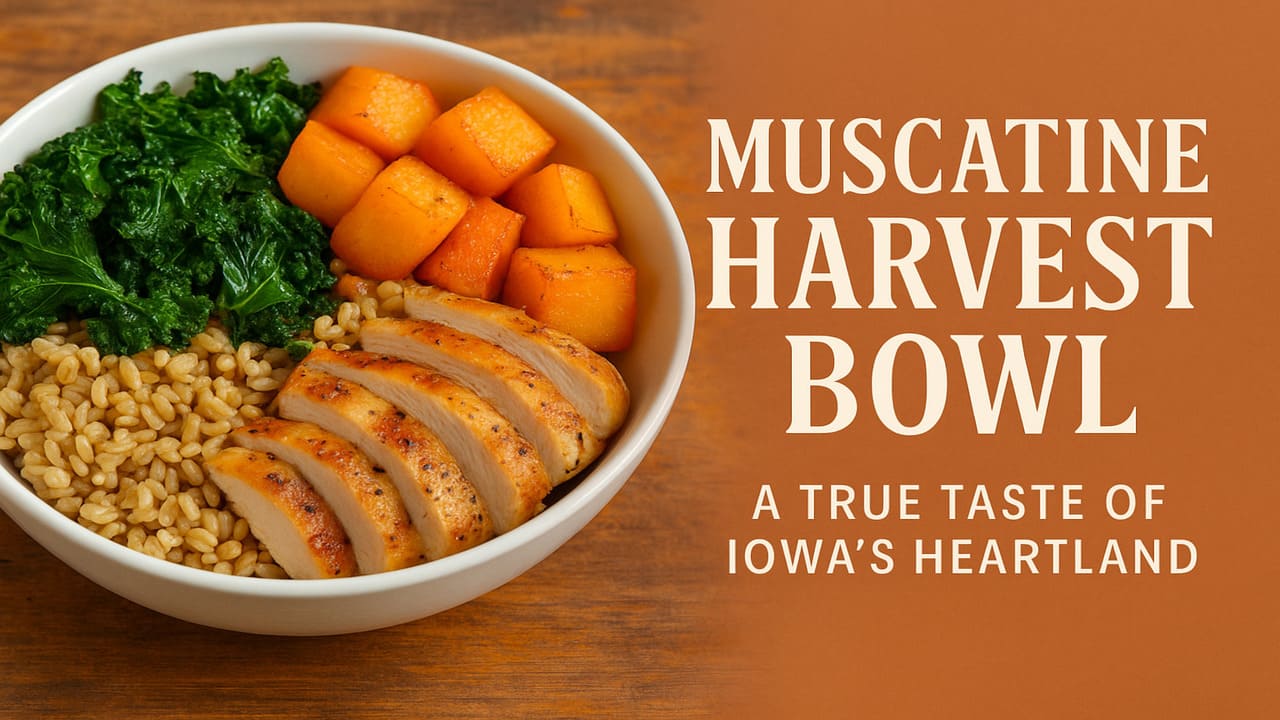
Meet Muscatine – In the gentle rhythm of southeastern Iowa’s farming life, where the Mississippi River carves its way past old grain silos and family-owned orchards, a new culinary creation is making quiet waves both nutritious and nostalgic. The Muscatine Harvest Bowl, a hearty and health-conscious dish built on the foundation of local produce, has emerged as a symbol of regional pride. It’s more than a meal it’s a story told through flavor.
With kale picked fresh from local gardens, roasted Muscatine melons, nutty grains, and slices of tender smoked chicken, this bowl offers a wholesome journey through the fields and farmlands of Iowa. Served both in cafés and family kitchens, it’s rapidly becoming a favorite among those who want to eat consciously without compromising on taste or tradition.
Every element in the Muscatine Harvest Bowl carries a sense of place. The kale, grown in backyard plots and small organic farms around the region, adds an earthy depth. Unlike mass-produced greens, these leaves are crisp and vivid in both color and flavor products of rich Midwestern soil and carefully rotated crops.
Then there’s the smoked chicken, a nod to Iowa’s enduring barbecue culture. Smoked using applewood or hickory chips, it brings a subtle complexity, tying the dish to family recipes and long-standing culinary rituals. It’s the type of meat that doesn’t just satisfy; it tells a story of time, smoke, and patience.
But what truly sets this bowl apart is the caramelized sweetness of roasted Muscatine melon. While many associate melons with summer picnics and juicy bites, roasting them brings out a richer, almost savory undertone. Grown in the sandy, mineral-rich soil near the Mississippi, Muscatine melons are know for their unrival sweetness. When roasted, their sugars intensify, creating a contrast that perfectly complements the bitterness of kale and the warmth of the grains.
At the core of the Muscatine Harvest Bowl is the farm-to-bowl philosophy. This isn’t just a trendy dish; it’s a conscious celebration of seasonality, sustainability, and community. Each bowl varies slightly depending on the time of year and the harvest. In late summer, you might find charred corn kernels or fresh tomatoes nestled beside the greens. In early fall, perhaps some butternut squash or pickled onions make their way in.
This dynamic nature not only keeps the dish exciting but also supports local agriculture. Restaurants and cafés that serve the Harvest Bowl often build relationships with nearby farmers and cooperatives. It becomes a cycle of mutual benefit diners receive food that is fresher and more flavorful, and growers find a consistent market for their produce.
This kind of ingredient-forward thinking is deeply embed in Muscatine’s culture. Despite being a relatively small city, it boasts a rich agricultural heritage and a growing reputation for farm-fresh fare. Local markets are vibrant, and seasonal festivals celebrate everything from sweetcorn to melons.
While the Muscatine Harvest Bowl is deeply rooted in tradition, it also fits comfortably within today’s health-focused lifestyles. Low in saturated fats and high in fiber and essential nutrients, it serves both flavor and function.
Nutritionists praise the combination of dark leafy greens, lean protein, and whole grains. The addition of melon adds antioxidants and natural sweetness, avoiding the need for added sugars or artificial dressings. Some variations even include a homemade vinaigrette made from local apple cider vinegar and cold-pressed sunflower oil, adding another layer of regional authenticity.
It’s no surprise that fitness enthusiasts, wellness bloggers, and everyday families have embraced the bowl. For many, it’s become a lunch staple something that nourishes both body and spirit, reminding them of where they’re from or where they long to be.
Read More : Mississippi Flavors: Culinary Adventures Along Muscatine’s Riverfront
As word spreads about this humble yet inspiring dish, the Muscatine Harvest Bowl is starting to appear on menus outside the city. Cafés in nearby towns are adopting the concept, sometimes with their own spin, but always paying tribute to the original vision local, fresh, and flavorful.
This marks an important moment for Muscatine’s food scene. For a long time, the city has been known for its scenic river views, historical buildings, and of course, its legendary melons. Now, it is building a reputation as a place where thoughtful, seasonal cuisine thrives.
Chefs and food entrepreneurs are beginning to see Muscatine as a destination not just for produce but for creativity and inspiration. In culinary circles, there’s growing appreciation for how this small community turns its harvest into something greater than the sum of its parts.